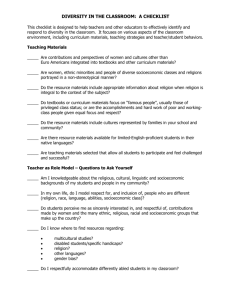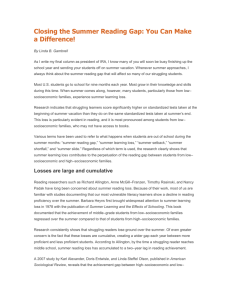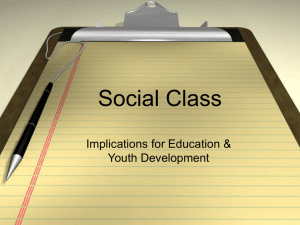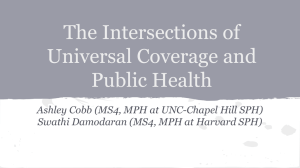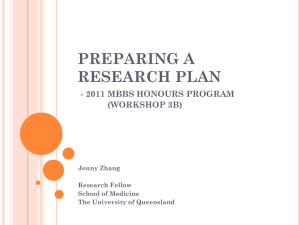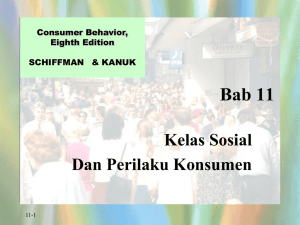Ainley Measuring socio
advertisement
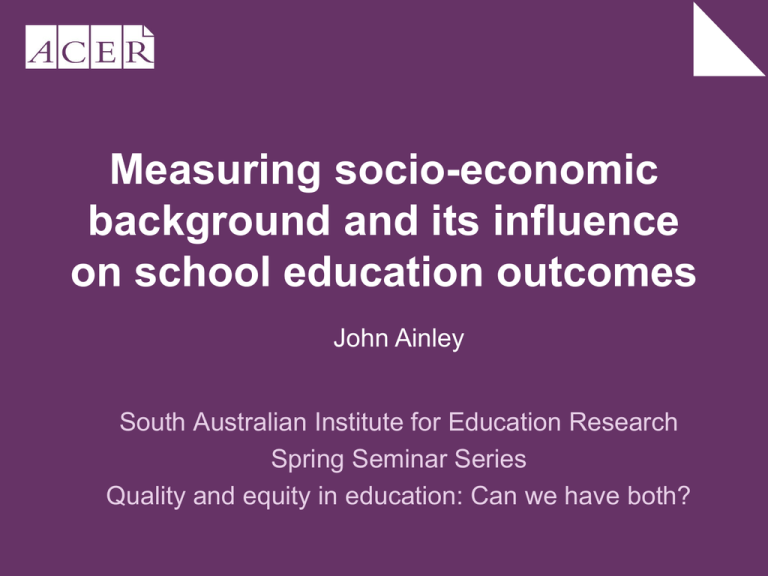
Measuring socio-economic background and its influence on school education outcomes John Ainley South Australian Institute for Education Research Spring Seminar Series Quality and equity in education: Can we have both? Outline • Introduction • What is meant by “socioeconomic status” and related concepts? • Students • Schools • How is socioeconomic status measured? • Students • Schools • How are the measures applied? • What are the implications for “quality and equality? Introduction • Enduring interest • socioeconomic status of parents and • educational outcomes of children • Range of special initiatives / funding • National – Disadvantaged schools program, National equity program for schools • State programs – Priority action schools program / Priority schools funding program • Other countries – Title 1 of Elementary and Secondary Education Act (USA) – Education action zones (UK) – Dutch Educational Opportunity Program Introduction (2) • Represents a status attainment model rather than a social class model • Extensively researched • Focus of meta-analytic reviews • White (1980), Sirin (2005) • New perspectives from international studies • Countries differ in the relationship between SES and outcomes • Differences relate to policies and cultural traditions Terminology Level Student School Terms Comment Socioeconomic status Defined in terms of parental occupation, education, wealth Social/socioeconomic disadvantage (or advantage) Also includes other factors such as Indigenous status, language background etc. Socioeconomic context Social-demographic composition or Community social educational advantage Either •aggregated student characteristics, or •community characteristics Definitions: Socioeconomic Status • Attained “status that depicts overall social standing” (Graetz, 1995) • Determined by individual achievements: • Employment or occupational status • Educational attainment • Income and wealth (Graetz, 1995, p 50). • Components sometimes used separately and sometimes as a combined index • Socioeconomic status of children is taken as that of their parents Concept of Social Advantage / Disadvantage • In addition to socioeconomic status includes other attributes • • • • • Indigenous status Language background Ethnicity Geographic location Residential mobility • Various combinations used Concept of Social / Socioeconomic Context • Refers to the aggregate composition of: – The school population – The community / area from which the school population is drawn • Aggregate compositional influences may be greater than the combination of individual influences • Usually based on the broad notion of advantage / disadvantage Measurement issues Socioeconomic status • Data sources: – Student reports – Large scale surveys e.g. PISA, LSAY – Parent supplied information – Some states such as Victoria – National Assessment Program (sample studies, NAPLAN) • Income and wealth not measured – Use indication of home possessions (books etc.) Measurement processes Socioeconomic status • Occupational status – Approach 1 • Code occupations as ASCO or ISCO codes • Transform ASCO / ISCO codes to status scores • Based on extensive empirical work on status • ANU5 scale(McMillan, Jones and colleagues) • ISEI scale (Ganzenboom and colleagues) • Results in scores on a continuous scale – Approach 2 (NAP etc) • Code occupations in five ordinal categories – If have data for two parents use the highest Measurement processes Socioeconomic status • Educational attainment – Based on a series of ordinal categories – Issues of scalability (VET school ?, intervals) • International surveys use ISCED categories • Nationally use ABS defined categories – If have data for two parents use the highest • Household possessions – Most commonly number of books – Problem of measurement equivalence Measurement processes Socioeconomic status • Combinations of components – E.g. PISA Indexes • HISEI – Highest International Socioeconomic Index • ESCS – Economic Social Cultural Status • Often used separately Measurement processes School socioeconomic context • Approach 1 Aggregate individual scores (e.g. SFO) – Various occupational categories and their weightings are used in the calculation of SFO as a weighted mean. • Approach 2 Use census data • • • • Code each students home address to a CCD Assign scores for the CCD to each student Combine selected measures to form an index Index is the average of scores Census based measures School socioeconomic context • Approach 2A Principal component weights • • • • Uses correlations among census measures Ross-Farish Indexes - used in disadvantaged schools ABS Socioeconomic Indexes for Areas (SEIFA) Indicator H from the socioeconomic model • Approach 2B Regression weights • Weight components for best prediction of achievement • ICSEA – used in MySchool (Index of Community Socio-Educational Advantage) • ICSEA currently being reviewed ICSEA Components • Components of SEIFA (14 components) – – – – – – % of people in a CCD with specified levels of income, % of people in a CCD with specified levels of educational qualifications % of people in a CCD with specified occupational categories % of one parent families with dependent offspring only, % of occupied private dwellings with no internet connection, %of people who identified themselves as Aboriginal or Torres Strait Islander • Census collection districts (CCDs) (where the students in a school live) • Accessibility/Remoteness Index of Australia (ARIA) - location • % Indigenous students enrolled • Mean = 1000 Standard deviation = 100 Year 3 Reading One state Year 9 Numeracy One state School Statistical Neighbours Type of group Fluid Single measure Multiple measures Basis of identification Fixed Current Scale-based Similarity-based Like schools Possible School Statistical Neighbours • Scale-based approach • Based on similar ICSEA scores • Closest scores above and below • Can be made of different mix of components • Alternative would be a cluster approach • Multidimensional approach • Define characteristics of interest • Look at schools that are similar in combination of characteristics An illustration Two approaches: three schools School Low SES (%) LBOTE (%) Athol Barre Colrain 10 30 5 30 10 35 Additive score 40 40 40 Student level results: Differences in PISA 2006 Reading Maths Score Gap Score Gap Highest quarter SES Lowest quarter SES 557 84 473 561 78 483 Non-Indigenous Indigenous 515 81 434 522 80 442 Metropolitan Provincial Remote 530 16 514 489 526 18 508 468 LBOTE ELB 517 20 497 523 521 Females Males 532 37 495 513 -14 527 25 2 40 International comparisons Maths 2003 and ESCS Unadjusted mean score Country Strength of relationship Slope of gradient Score point difference % explained variation in associated with one unit student performance on the ESCS Canada Finland Australia Sweden New Zealand United States Germany Belgium 532 544 524 509 523 483 503 529 11 11 14 15 17 19 23 24 34 33 42 42 44 45 47 55 OECD mean 500 20 45 International comparisons: Within and between-schools Overall Country Finland Canada Sweden Australia New Zealand United States Germany Belgium Within-school Student-level Score point score point difference difference associated with associated with one unit on the one unit on the ESCS student-level ESCS 33 34 42 42 44 45 47 55 33 25 38 27 33 31 17 25 Explained within-school variance 10 6 12 5 10 9 4 7 Between-school Index School-level score point difference Explained Percentage of associated with between-school ESCS variation one unit on the variance within schools school mean ESCS -2 39 29 57 55 55 90 97 22 47 53 70 75 69 77 74 89 82 88 74 83 77 70 68 Continuation to Year 12 2001 2005 % Year 12 Gap % Year 12 Gap Professional-managerial Skilled or unskilled manual 85 72 13 90 82 8 Non-Indigenous Indigenous 80 54 26 85 70 15 Metropolitan Provincial Remote 82 87 78 80 7 LBOTE* ELB* 86 78 8 96 85 11 Females Males 83 75 8 87 81 6 Base 8 74 Year 9 in 1998 PISA 2003 Summary • Socioeconomic status is a major correlate of outcomes • Can be measured at an individual or aggregate level • Achievement distribution is not as equitable in Australia as we would like to think • Greater variation within schools than between schools • It is possible to have greater equality without loss of quality Thank you Comments Discussion Questions
